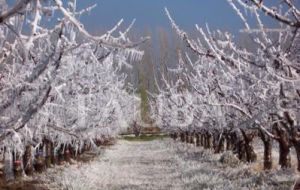MercoPress. South Atlantic News Agency
Chilean fruit industry compensates smaller shipments with higher global prices
 Because of the freezing spell orange exports are predicted to drop 40%
Because of the freezing spell orange exports are predicted to drop 40% Despite sharp declines in the volume of exported fruits during the 2009-2010 season Chile’s fruit industry managed to offset those losses because of higher prices paid in foreign markets.
Chilean fruit exports totalled about 3 billion US dollars according to preliminary numbers from the industry. This represents a 5% increase in revenue from the 2008-2009 season.
According to the National Agriculture Society (SNA), the total export volumes remained virtually the same, after declining 0.6%, totalling 2.3 million tons. Though shipment sizes of seven of the 11 major fruits decreased, shipments of avocados and kiwis increased.
The revenue from avocado exports rose strongly (156.6%), after two seasons of poor production due to frosts in 2007. The 2009-2010 season ended with avocado exports close to 200,000 tons. Without the avocado, fruit export volumes would have fallen 5.9% this season.
Many factors this year are working against the fruit industry of Chile, one of the largest fruit exporters in the world. Ronald Brown, president of the Association of Exporters, said these reasons are to blame for the fall in revenue: “This is due to climatic factors, to damage caused by the earthquake, and to a two to three week late harvest in table grapes, apples and kiwis”.
Brown referred to the 8.8 magnitude earthquake on Feb. 27, which centred on a key agricultural area, and the cold spell that hit South America at the beginning of this month, which worried some about production levels of export fruits. Because of this cold front, experts predicted orange exports to fall about 40% and avocado exports to decrease about 15%.
On July 14, the Aysén Region (XI) was declared an agricultural emergency area because of extremely cold temperatures at the time. The government is now distributing bonuses and aid of about 242,000 USD to farmers near Coyhaique and Río Ibáñez. The deadline for distribution is Aug. 30. Raul Rudolphi, regional secretary of agriculture in Aysén, explained that the deadline gave the government “a little over a month to assess the situation and so we don’t fail to deliver the necessary support where needed”.
For the 2010-2011 season, the recent severe frost could lead to decreases in production and thus shipments of avocados by 30 percent, said Antonio Walker, president of Fedefruta, a trade organization of fruit producers. Many also worried that citrus fruits would be affected by the low temperatures, but Bown said 75% of the crop was already harvested, so the damage would be minor.
José Manuel Alcaíno, president of Decofrut (a fruit industry analysis and service provider), said boxes of table grapes, Chile’s largest fruit export by volume, shipped to the East Coast of the United States were traded at 23 USD each on average, against 16.7 USD last season. A similar increase occurred with the Gala Apples exported to Europe; the value recorded an increase of 13%, reaching an average price of 17 USD.
By Laura French – Santiago Times




Top Comments
Disclaimer & comment rulesCommenting for this story is now closed.
If you have a Facebook account, become a fan and comment on our Facebook Page!